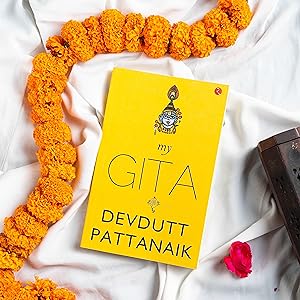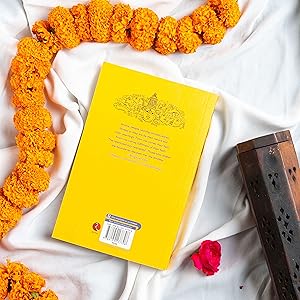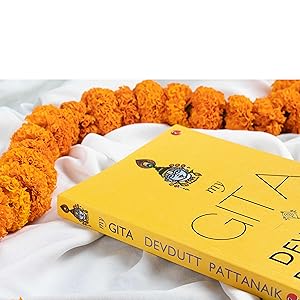
Download the free Kindle app and start reading Kindle books instantly on your smartphone, tablet or computer – no Kindle device required.
Read instantly on your browser with Kindle for Web.
Using your mobile phone camera, scan the code below and download the Kindle app.

OK
 Audible sample Sample
Audible sample Sample 


MY GITA Paperback – Special Edition, 11 November 2015
Save Extra with 2 offers
- Free Delivery
- 10 days Replacement
- Amazon Delivered
- Pay on Delivery
- Secure transaction
10 days Replacement
| Replacement Reason | Replacement Period | Replacement Policy |
|---|---|---|
| Wrong and Missing Item, Defective, Physical Damage | 10 days from delivery | Replacement |
Replacement Instructions

Read full returns policy

Explore your book, then jump right back to where you left off with Page Flip.
View high quality images that let you zoom in to take a closer look.
Enjoy features only possible in digital – start reading right away, carry your library with you, adjust the font, create shareable notes and highlights, and more.
Discover additional details about the events, people, and places in your book, with Wikipedia integration.
Purchase options and add-ons
- Print length256 pages
- LanguageEnglish
- PublisherRupa Publications India
- Publication date11 November 2015
- Dimensions19.83 x 12.85 x 1.48 cm
- ISBN-109788129137708
- ISBN-13978-8129137708
Frequently bought together

Popular titles by this author
 The journey from human to divine is to achieve conceptual clarity and appreciate the world as it is, while empathizing with how others perceive it.Highlighted by 898 Kindle readers
The journey from human to divine is to achieve conceptual clarity and appreciate the world as it is, while empathizing with how others perceive it.Highlighted by 898 Kindle readers Dharma is more about empathy than ethics, about intent rather than outcome. I follow dharma when I am concerned about your material, emotional or intellectual hunger. I follow adharma when I focus on my hunger at the cost of yours.Highlighted by 810 Kindle readers
Dharma is more about empathy than ethics, about intent rather than outcome. I follow dharma when I am concerned about your material, emotional or intellectual hunger. I follow adharma when I focus on my hunger at the cost of yours.Highlighted by 810 Kindle readers Dhritarashtra’s blindness is not so much the absence of sight as the absence of empathy.Highlighted by 768 Kindle readers
Dhritarashtra’s blindness is not so much the absence of sight as the absence of empathy.Highlighted by 768 Kindle readers
From the Publisher

Conversation with Devdutt Pattanaik
The Bhagavad Gita, or The Gita as it is popularly known, is part of the epic Mahabharata.
The epic describes the war between the Pandavas and the Kauravas on the battlefield of Kuru-kshetra. The Gita is the discourse given by Krishna to Arjuna just before the war is about to begin. Krishna is identified as God (bhagavan). His words contain the essence of Vedic wisdom, the keystone of Hinduism.
Ramkrishna Paramhansa, the nineteenth-century Bengali mystic, said that the essence of The Gita can be deciphered simply by reversing the syllables that constitute Gita. So Gita, or gi-ta, becomes ta-gi, or tyagi, which means 'one who lets go of possessions.'
Given that, it is ironical that I call this book ‘My Gita’. I use the possessive pronoun for three reasons.

Reason 1: My Gita is thematic
The Gita demonstrates many modern techniques of communication. First, Arjuna’s problem is presented (Chapter 1), and then Krishna’s solution (chapters 2 to 18) is offered. Krishna begins by telling Arjuna what he will reveal (Chapter 2); he then elaborates on what he promised to tell (chapters 3 to 17); and finally, he repeats what he has told (Chapter 18). Krishna’s solution involves analysis (sankhya) and synthesis (yoga)—slicing the whole into parts and then binding the parts into a whole. The solution itself is comprehensive, involving the behavioural (karma yoga), the emotional (bhakti yoga) and the intellectual (gyana yoga). However, no one reads The Gita as a book, or hears every verse in a single sitting.

Traditionally, a guru would only elaborate on a particular verse or a set of verses or a chapter of The Gita at a time. It is only in modern times, with a printed book in hand, that we want to read The Gita cover to cover, chapter by chapter, verse to verse, and hope to work our way through to a climax of resolutions in one go. When we attempt to do so, we are disappointed.
For, unlike modern writing, The Gita is not linear: some ideas are scattered over several chapters, many ideas are constantly repeated, and still others presuppose knowledge of concepts found elsewhere, in earlier Vedic and Upanishadic texts. In fact, The Gita specifically refers to the Brahma sutras (Chapter 13, Verse 5), also known as Vedanta sutras, said to have been composed by one Badarayana, sometimes identified with Vyasa.
Further, at places, the same words are used in different verses to convey different meanings, and at other instances, different words are used to convey the same idea. For example, sometimes the word ‘atma’ means mind and sometimes soul; at other times other words like dehi, brahmana and purusha are used for soul instead of atma. This can be rather disorienting to a casual reader, and open to multiple interpretations. So My Gita departs from the traditional presentation of The Gita—sequential verse-by-verse translations followed by commentary. Instead, My Gita is arranged thematically. The sequence of themes broadly follows the sequence in The Gita. Each theme is explained using several verses across multiple chapters. The verses are paraphrased, not translated or transliterated. These paraphrased verses make better sense when juxtaposed with Vedic, Upanishadic and Buddhist lore that preceded The Gita and
stories from the Mahabharata, the Ramayana and the Puranas that followed it. Understanding deepens further when the Hindu worldview is contrasted with other worldviews and placed in a historical context. For those seeking the standard literal and linear approach, there is a recommended reading list at the end of the book.
Reason 2: My Gita is subjective
We never actually hear what Krishna told Arjuna. We simply overhear what Sanjaya transmitted faithfully to the blind king Dhritarashtra in the comforts of the palace, having witnessed all that occurred on the distant battlefield, thanks to his telepathic sight. The Gita we overhear is essentially that which is narrated by a man with no authority but infinite sight (Sanjaya) to a man with no sight but full authority (Dhritarashtra). This peculiar structure of the narrative draws attention to the vast gap between what is told (gyana) and what is heard (vi-gyana).
Krishna and Sanjaya may speak exactly the same words, but while Krishna knows what he is talking about, Sanjaya does not. Krishna is the source, while Sanjaya is merely a transmitter. Likewise, what Sanjaya hears is different from what Arjuna hears and what Dhritarashtra hears. Sanjaya hears the words, but does not bother with the meaning. Arjuna is a seeker and so he decodes what he hears to find a solution to his problem. Dhritarashtra is not interested in what Krishna has to say. While Arjuna asks many questions and clarifications, ensuring the ‘discourse’ is a ‘conversation’, Dhritarashtra remains silent throughout. In fact, Dhritarashtra is fearful of Krishna who is fighting against his children, the Kauravas. So he judges Krishna’s words, accepting what serves him, dismissing what does not.
Krishna Arjuna (source) (seeker) Sanjaya Dhritarashtra (transmitter) (judge) Me You
Overhearing the Gita
I am not the source of The Gita. But I do not want to be merely its transmitter, like Sanjaya. I want to understand, like Arjuna, though I have no problem I want to solve, neither do I stand on the brink of any battle. But it has been said that the Vedic wisdom presented by Krishna is applicable to all contexts, not just Arjuna’s. So I have spent months hearing The Gita in the original Sanskrit to appreciate its musicality; reading multiple commentaries, retellings and translations; mapping the patterns that emerge from it with patterns found in Hindu mythology; and comparing and contrasting these patterns with those found in Buddhist, Greek and Abrahamic mythologies. This book contains my understanding of The Gita, my subjective truth: my Gita. You can approach this book as Arjuna, with curiosity, or as Dhritarashtra, with suspicion and judgement. What you take away will be your subjective truth: your Gita.
The quest for objective truth (what did Krishna actually say?) invariably results in vi-vaad, argument, where you try to prove that your truth is the truth and I try to prove that my truth is the truth. The quest for subjective truth (how does The Gita make sense to me?) results in sam-vaad, where you and I seek to appreciate each other’s viewpoints and expand our respective truths. It allows everyone to discover The Gita at his or her own pace, on his or her own terms, by listening to the various Gitas around them.
Objectivity is obsessed with exactness and tends to be rather intolerant of deviation, almost like the jealous God of monotheistic mythologies. But meanings change over time, with the personality of the reader, and with context. Subjectivity challenges the assumption that ideas are fixed and can be controlled; it celebrates the fluid. Modern global discourse tends to look at truth qualitatively: it is either true or false. That which is objective is scientific and true. That which is subjective is mythic and false. Hindu thought, however, looks at truth quantitatively: everyone has access to a slice (bhaga); the one who sees all slices of truth is bhaga-van. Limited truth is mithya. Limitless truth is satya. Satya is about including everything and being whole (purnam).
The journey towards limitless truth expands our mind
(brahmana). The Gita itself values subjectivity: after concluding his counsel, Krishna tells Arjuna to reflect on what has been said, and then do as he feels (yatha-ichasi-tatha-kuru). Even Sanjaya, after giving his view on what Krishna’s discourse potentially offers, concludes The Gita with the phrase ‘in my opinion’ (mati-mama).
Reason 3: My Gita is not obsessed with the self
Traditionally, The Gita has been presented as a text that focusses on self-realization (atma-gyana). This suits the hermit who isolates himself from society. This is not surprising, since most early commen tators and retellers of The Gita, such as Shankara, Ramanuja, Madhwa and Dyaneshwara, chose not to be householders. The original Buddhist monastic order may not have survived in India, but it did play a key role in the rise and dominance of the Hindu monastic order. The monastic approach willy-nilly appeals to the modern individualist, who also seeks self-exploration, self-examination, self-actualization and, of course, selfies.
Get your copy to immerse yourself in this great text….
Product description
About the Author
Product details
- ASIN : 8129137704
- Publisher : Rupa Publications India; My Gita Special Edition (11 November 2015); Rupa Publications India
- Language : English
- Paperback : 256 pages
- ISBN-10 : 9788129137708
- ISBN-13 : 978-8129137708
- Item Weight : 270 g
- Dimensions : 19.83 x 12.85 x 1.48 cm
- Net Quantity : 1 Count
- Importer : Unkown
- Packer : Unkown
- Generic Name : Printed Book
- Best Sellers Rank: #1,885 in Books (See Top 100 in Books)
- #66 in Historical Fiction (Books)
- Customer Reviews:
About the author

Devdutt Pattanaik was trained in medicine, and worked in the pharmaceutical and healthcare industry for fifteen years, before turning his part-time passion for mythology into his full-time profession. He has authored over 1000 articles and over 50 books on the relevance of sacred stories, symbols and rituals in modern times. These have been translated in Hindi, Marathi, Malayalam, Kannada, Tamil, Telugu, Gujarati and many international languages including Russian, Polish and Japanese. He is a much sought after corporate speaker and acts as a consultant to organisations on matters related to leadership and culture.
Customer reviews
Reviews with images
-
Top reviews
Top reviews from India
There was a problem filtering reviews right now. Please try again later.

How Krishna answers to all the dilemmas arjuna has before the battle takes place during the battle of Kurukshetra in Mahabharata.
They say there are answers to all the questions you have with life in the Bhagavad Gita and it is soo true.
It's written very beautifully by Devdutt Pattanaik this is my second book of his and he just keeps impressing me with each one I finish.
I feel this book has lots of lessons and values to add to your life. It's an ancient philosophy and it hasn't changed much and holds true to this day and age. Easy and good read.
Where Krishna yokes the mind and Arjuna bears the bow, there is always fortune, success, domination, stability, and law. That is my opinion - Bhagavad Gita: Chapter 18, Verse 78
How Krishna answers to all the dilemmas arjuna has before the battle takes place during the battle of Kurukshetra in Mahabharata.
They say there are answers to all the questions you have with life in the Bhagavad Gita and it is soo true.
It's written very beautifully by Devdutt Pattanaik this is my second book of his and he just keeps impressing me with each one I finish.
I feel this book has lots of lessons and values to add to your life. It's an ancient philosophy and it hasn't changed much and holds true to this day and age. Easy and good read.
Where Krishna yokes the mind and Arjuna bears the bow, there is always fortune, success, domination, stability, and law. That is my opinion - Bhagavad Gita: Chapter 18, Verse 78

This book might appear quite flat to some and might take some on a nice inner journey of learnings & introspection.
However for the most of the beginners looking to grasp Gita; the literal translation is a bit too much to handle at first. Literals translations read like shlokas & hymns and a regular person is lost . There are lot of concepts and thoughts that are taken back and forth. There is also an assumption that you are aware of some concepts to appreciate what is being conveyed. All this is quite overwhelming for someone who is just starting with the journey. You do discover eventually the beauty and message- but you need to revisit this again and depending on the stage of life you are and your mental composition- Gita listens to you, speaks to you, guides you and nourishes you.
Devdutt Pattanaik needs no introduction today and this brilliant work of his is what overcomes the primary obstacle for a beginner wrt other equally brilliant works on Gita. This commentary on Gita by Mr. Pattanaik does not have the same flow of concepts as Original Gita rather concepts are introduced logically for easier grasp, hence we are talking about a concept say in chapter 15 of this book which may have been introduced in chapter 3 in Gita. The conversation between Krishna and Arjuna are paraphrased for your and my benefit. Mr. Pattanaik has also elaborated on the history of Gita and his view point on the evolution of Hinduism and comparisons of thoughts & concepts with Greek, Abrahamic and Buddhism. He has interlaced it all with perspective of our life in this era and this more than ever emphasizes the need of understanding Gita in today's world. Mr. Pattanaik has also mentioned references in case you wish to read further on Gita. This is highly appreciated. I would especially recommend Eknath Easwaran's translations of Gita (http://www.amazon.in/dp/818495090X)
The capsuled message is- if you are looking to read Gita for the first time this where your search ends. If you have already read Gita and looking to clear some of your doubts or want to read a new commentary-again your search ends here!
I want to end this review with this paragraph from the book, which essentially conveys our potential and the role we are expected to play
'I want you to be Bhagavan: see my slice of reality, my insecurity and my vulnerability, and comfort me, without making me feel small. You have that potential. So do I, If not you and I, then surely there is somebody else.'































